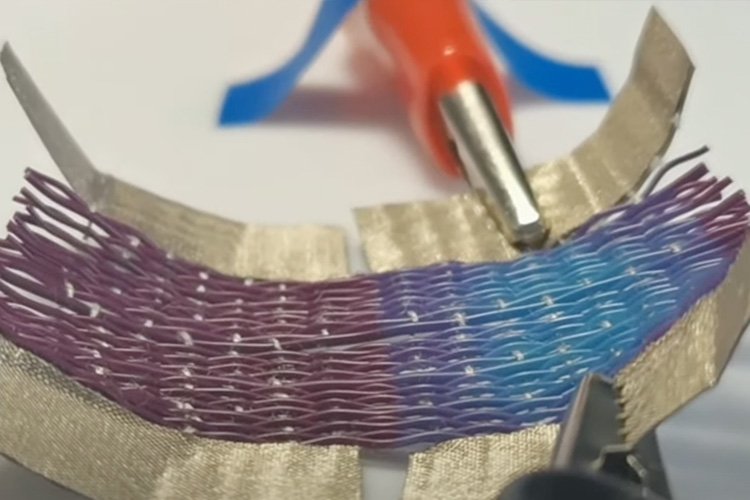A team of researchers from the University of Waterloo has created a new smart material that can change its shape and color after being activated by heat and electricity. The achievement marks the first time that a stimuli-responsive material has been able to respond to two different stimuli.
The innovative fabric has the potential to be used in a wide range of applications, from clothing that warms up as you move to vehicle bumpers that return to their original shape after an accident.
The smart material combines highly engineered composites and stainless steel to form what researchers call a “happy union of soft and hard materials.”
Researchers say they developed a process to weave the smart fabric that is “extremely versatile” and allows for design freedom and macro-scale control of its properties by creating a device similar to a traditional loom.
But it’s not just the fabric’s physical properties that make it so unique.
The breakthrough smart material can change its color and shape by applying a combination of heat and electricity. And because changes can be activated by low-voltage electricity, researchers say the new smart material is more energy-efficient and cost-effective than previous systems.
Dr. Milad Kamkar, a chemical engineering professor at Waterloo, believes that the potential uses of this material are almost infinite, particularly in the fields of AI, robotics, and virtual reality.
“Imagine feeling warmth or a physical trigger eliciting a more in-depth adventure in the virtual world,” Dr. Kamkar told the Waterloo News.
Uses of this material aren’t just limited to the virtual world. Previous research into stimuli-responsive materials has only focused on the ability of smart materials to change in response to a single environmental stimulus.
Because this new smart material can sense and react to multiple environmental stimuli, it has the potential to pave the way for genuinely effective smart systems such as camouflage, biomedical devices, or environmental sensors.
“Through the ability to sense and react to environmental stimuli such as temperature, this is proof of concept that our new material can interact with the environment to monitor ecosystems without damaging them,” said Dr. Kamkar.
What’s particularly exciting about this development is that the fabric is made from polymer nano-composite fibers from recycled plastic, making it an environmentally friendly option. Because it’s programmable, it also has the potential to reduce waste by being used in a variety of different applications.
Researchers say the next step is to improve the fabric’s shape-memory performance for use in robotics. Using this innovative material, they hope to create a robot that can carry and transfer weight effectively.
Overall, this new smart material has the potential to revolutionize the way we think about clothing, vehicle design, robotics, and more. Its ability to respond to both heat and electricity opens up a whole new world of possibilities, and its versatility and energy efficiency could mark a fascinating development in the world of materials science.
The research team’s paper, “Multi-Stimuli Dually-Responsive Intelligent Woven Structures with Local Programmability for Biomimetic Applications,” has been published in the journal Nano-Micro Small.
Tim McMillan is a retired law enforcement executive, investigative reporter and co-founder of The Debrief. His writing typically focuses on defense, national security, the Intelligence Community and topics related to psychology. You can follow Tim on Twitter: @LtTimMcMillan. Tim can be reached by email: tim@thedebrief.org or through encrypted email: LtTimMcMillan@protonmail.com

